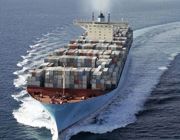
Container lines are ignoring a drop in freight rates and bringing the highest proportion of the shipping fleet out of mothballs since 2008, when the global slump resulted in the industry’s biggest losses.
The capacity of idled ships has dropped to about 80,000 containers, according to industry consultant Alphaliner. That’s the smallest number of vessels not in use since the collapse of Lehman Brothers Holdings Inc. three years ago triggered a worldwide recession.
Overcapacity threatens to limit the usual seasonal advance in third-quarter rates to Europe, hurting earnings for such shipping lines as Copenhagen-based A.P. Moeller-Maersk A/S, the world’s largest. About 45 percent of goods to Europe from Asia are being transported at a loss and shipping lines need to cut capacity for the route by as much as 10 percent to balance supply and demand, Nordea Bank AB said June 29.
“Our view on the container market is relatively negative due to the overcapacity there today,” said Torkel Aaberg, an Oslo-based fund manager at KLP Asset Management. The fund, which has about $46 billion under management, holds about $3.3 million in Maersk shares and is under-weighting the stock compared with other equity holdings, he said. “Rates are really bad. Our view here is that Maersk will perform worse than other stocks” in KLP’S portfolio.
Shares of Maersk, Denmark’s biggest company, have lost 13 percent this year compared with a 4.6 percent decline in the OMX Copenhagen 20 index. The world’s second-biggest shipping line, Geneva-based Mediterranean Shipping Co., and Marseille-based CMA CGM SA, the third-largest, are both privately held.
Shipping lines are not cutting capacity because ships they have ordered are now coming on line, because vessel-sharing agreements require multiple negotiators to cut capacity and because the first company to do so loses market share until others follow.
“It’s a waiting game,” Rahul Kapoor, a container analyst at RS Platou Markets AS, said by phone from Singapore. “Every shipping line wants the other ones to cut capacity first.”
The difference between now and the 2009 slump is that the market is growing, not shrinking.
Source: Bloomberg
We use cookies to improve your experience. By continuing to use our site, you accept our Cookies, Privacy Policy,Terms and Conditions. Close X